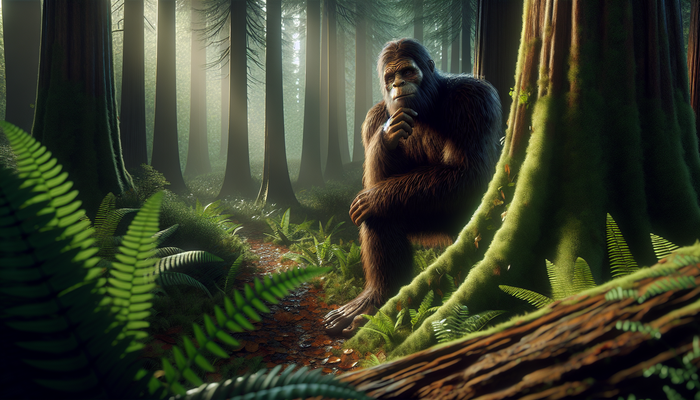Exploring Cryptid Detection Technologies: Tools for Uncovering the Unknown

By Ava Martinez, Cryptozoologist
The Evolution of Cryptozoology: From Folklore to Scientific Inquiry
The roots of cryptozoology stretch back to ancient times, when tales of strange beasts populated the myths and legends of cultures worldwide. However, it wasn't until the mid-20th century that the field began to take shape as a more formalized area of study. Belgian zoologist Bernard Heuvelmans coined the term "cryptozoology" in 1955, seeking to bring scientific rigor to the investigation of animals known only through anecdotal evidence or folklore.
Heuvelmans' work marked a significant shift in how unexplained animal sightings were approached. Rather than dismissing such accounts outright, cryptozoologists aimed to collect and analyze evidence, however anecdotal, in the hope of uncovering new species. This approach, while often criticized by mainstream scientists, opened up new avenues for exploration and discovery.
The role of eyewitness accounts in cryptozoology cannot be overstated. These firsthand reports form the backbone of many cryptid investigations, providing researchers with valuable leads and insights. However, the subjective nature of such accounts presents a significant challenge. Human perception is notoriously unreliable, influenced by factors such as expectation, cultural context, and environmental conditions. This inherent unreliability has long been a sticking point for skeptics, who argue that eyewitness testimony alone is insufficient to prove the existence of cryptids.
Enter modern technology. As we'll see, the integration of advanced detection tools has begun to bridge the gap between anecdotal evidence and scientific verification, offering new ways to search for and document these elusive creatures.
Camera Traps: The Silent Sentinels of Cryptid Research
One of the most significant advancements in cryptid detection technology is the widespread use of camera traps. These motion-activated devices have revolutionized wildlife research, allowing scientists to capture images and videos of elusive animals without human presence. In the realm of cryptozoology, camera traps have become invaluable tools for researchers seeking evidence of cryptids.
The principle behind camera traps is simple yet effective. When an animal moves in front of the camera, it triggers a sensor that activates the device, capturing a series of images or a short video clip. This automated system allows researchers to monitor vast areas of wilderness continuously, increasing the chances of documenting rare or unknown species.
In North America, camera traps have been extensively deployed in the search for Bigfoot. Researchers strategically place these devices in areas with frequent Bigfoot sightings, hoping to capture definitive proof of the creature's existence. While conclusive evidence remains elusive, some intriguing images have emerged from these efforts, fueling ongoing debates about the reality of Sasquatch.
The use of camera traps in cryptid research extends beyond Bigfoot. In the dense jungles of Southeast Asia, researchers have used these devices to search for evidence of the Orang Pendek, a small, bipedal primate reported to inhabit the forests of Sumatra. Similarly, camera traps have been employed in the quest for the Thylacine, or Tasmanian Tiger, an animal officially declared extinct in 1936 but rumored to still exist in remote parts of Tasmania and mainland Australia.
While camera traps have yet to provide irrefutable proof of any cryptid's existence, they have contributed valuable data to the field. These devices have captured images of rare and elusive known species, demonstrating their effectiveness in documenting animals that are difficult to observe directly. This success in mainstream wildlife research lends credibility to their use in cryptozoology, offering hope that one day, a camera trap might capture the first clear image of a previously unknown creature.
Thermal Imaging: Seeing the Unseen
As the sun sets and darkness falls, many cryptids are said to become more active. This nocturnal behavior presents a significant challenge for researchers, as traditional visual observation methods become ineffective. Enter thermal imaging technology, a game-changer in nighttime cryptid research.
Thermal cameras detect heat emitted by objects and living creatures, creating a visual representation of temperature differences. This capability makes them ideal for spotting warm-bodied animals in low visibility conditions, potentially revealing the presence of cryptids that might otherwise remain hidden in the shadows.
The application of thermal imaging in cryptozoology has been particularly notable in the search for creatures like the Mothman, a winged humanoid reportedly seen in Point Pleasant, West Virginia. Researchers have used thermal cameras to scan the skies and forests where Mothman sightings have occurred, hoping to detect any unusual heat signatures that might correspond to the legendary creature.
In the waters of Scotland's Loch Ness, thermal imaging has been employed in the ongoing quest to find the famed Nessie. In 2019, researchers conducted an extensive survey of the loch using drones equipped with thermal cameras. While they didn't find conclusive evidence of a monster, they did detect several unexplained heat signatures, demonstrating the technology's potential to uncover anomalies that warrant further investigation.
Thermal imaging has also proven valuable in the search for more terrestrial cryptids. Bigfoot researchers have used handheld thermal cameras during nighttime expeditions, scanning the forest for any bipedal heat signatures that might indicate the presence of the elusive creature. While skeptics argue that such signatures could easily be misidentified humans or known animals, proponents of the technology argue that it provides a unique perspective that complements other research methods.
One of the most intriguing aspects of thermal imaging in cryptozoology is its ability to potentially capture evidence of creatures that might be invisible to the naked eye. Some researchers speculate that certain cryptids could possess natural camouflage or even the ability to bend light around their bodies, rendering them virtually invisible under normal conditions. Thermal cameras, by detecting heat rather than light, could theoretically reveal the presence of such beings.
Despite its potential, thermal imaging technology is not without limitations. Environmental factors such as ambient temperature, humidity, and vegetation can all affect the clarity and accuracy of thermal images. Additionally, the technology cannot distinguish between different species based on heat signatures alone, meaning that any unusual readings would require further investigation to determine their source.
Drones: Eyes in the Sky
The advent of affordable, high-quality drones has opened up new possibilities for cryptid researchers. These unmanned aerial vehicles, equipped with high-resolution cameras and sometimes thermal imaging capabilities, allow investigators to survey vast areas of wilderness from above, accessing terrain that would be difficult or dangerous to explore on foot.
In the search for aquatic cryptids like the Loch Ness Monster, drones have proven particularly useful. They can cover large bodies of water quickly, capturing aerial footage that might reveal unusual disturbances or objects beneath the surface. In 2015, a drone-captured image of what appeared to be a large, serpentine shape in Loch Ness caused a stir in the cryptozoology community. While the object was later determined to be a submerged log, the incident highlighted the potential of drone technology to provide new perspectives in cryptid research.
Drones have also been employed in the search for land-based cryptids. In the dense forests of the Pacific Northwest, researchers have used drones to conduct aerial surveys of areas associated with Bigfoot sightings. The bird's-eye view provided by drones allows investigators to identify potential habitats, track patterns of movement, and even spot structures or formations that might be indicative of Sasquatch activity.
One of the most innovative applications of drone technology in cryptozoology involves the use of thermal imaging cameras mounted on these aerial platforms. This combination allows researchers to conduct nighttime surveys of large areas, potentially detecting the heat signatures of cryptids that might be active after dark. In 2019, a team searching for the legendary Chupacabra in Puerto Rico used thermal-equipped drones to scan remote areas of the island, hoping to catch a glimpse of the elusive creature.
The use of drones in cryptid research is not without controversy. Privacy concerns and regulations regarding drone usage can limit where and how these devices can be employed. Additionally, the noise generated by drones may disturb wildlife and potentially scare away the very creatures researchers are hoping to document. Despite these challenges, the aerial perspective provided by drones continues to be a valuable tool in the cryptozoologist's arsenal, offering new ways to explore and document the habitats where cryptids are said to dwell.
Environmental DNA: Invisible Clues in the Ecosystem
One of the most promising and scientifically rigorous tools in modern cryptozoology is the analysis of environmental DNA (eDNA). This technique involves collecting samples from the environment—such as soil, water, or air—and analyzing them for genetic material left behind by organisms. In the context of cryptid research, eDNA analysis offers the tantalizing possibility of detecting the presence of unknown species without the need for direct observation or capture.
The potential of eDNA in cryptozoology was dramatically demonstrated in a 2019 study of Loch Ness. An international team of researchers collected water samples from various depths and locations throughout the loch, then analyzed them for DNA traces. While they didn't find evidence of a prehistoric reptile or giant fish, they did uncover a surprisingly diverse ecosystem, including the DNA of several species not previously known to inhabit the loch.
This Loch Ness study highlighted both the promise and the limitations of eDNA analysis in cryptid research. On one hand, it provided a comprehensive survey of life in the loch, demonstrating the technique's ability to detect even minute traces of genetic material. On the other hand, it underscored the challenge of interpreting eDNA results, as the presence of DNA doesn't necessarily indicate the current presence of a living organism.
Beyond Loch Ness, eDNA analysis has been applied to other cryptozoological investigations. In the Pacific Northwest, researchers have collected soil and water samples from areas associated with Bigfoot sightings, hoping to detect genetic material that doesn't match any known species. Similar techniques have been used in the search for the Orang Pendek in Sumatra and the Thylacine in Tasmania.
One of the most intriguing aspects of eDNA analysis is its potential to detect the presence of species that are extremely rare or thought to be extinct. In 2017, researchers used eDNA techniques to confirm the presence of the scimitar-horned oryx in Chad, years after the species was declared extinct in the wild. This success story offers hope to cryptozoologists, suggesting that eDNA could potentially reveal the existence of animals that have managed to evade direct detection.
However, the application of eDNA in cryptozoology is not without challenges. Contamination of samples is a significant concern, as even trace amounts of human or known animal DNA can skew results. Additionally, the degradation of genetic material over time can limit the effectiveness of eDNA analysis, particularly in aquatic environments where DNA doesn't persist for long periods.
Despite these limitations, eDNA analysis represents a significant step forward in the scientific approach to cryptozoology. By providing a way to detect the genetic signatures of organisms without direct observation, it offers a bridge between the anecdotal evidence that has long dominated the field and the rigorous scientific proof demanded by skeptics.
Audio Technology: Listening for the Unknown
In the quest to document cryptids, researchers have long recognized the importance of sound. Many cryptids are associated with distinctive vocalizations, from the eerie howls attributed to Bigfoot to the low-frequency rumbles said to emanate from lake monsters. Advanced audio recording technology and sound analysis software have become crucial tools in the cryptozoologist's arsenal, offering new ways to capture and interpret these mysterious sounds.
High-sensitivity microphones, capable of picking up a wide range of frequencies, are often deployed in areas where cryptids have been reported. These devices can be left in the field for extended periods, continuously recording ambient sounds. Some researchers use parabolic microphones, which can focus on distant sounds, potentially capturing vocalizations from creatures that remain out of visual range.
One of the most notable applications of audio technology in cryptid research has been in the search for Bigfoot. Researchers have recorded numerous instances of strange, powerful vocalizations in remote forests, often described as howls, whoops, or knocks. These recordings are then subjected to rigorous analysis, comparing them to known animal sounds and human vocalizations to determine their origin.
In 2013, a team of researchers in Oregon captured a series of unusual howls that garnered significant attention in the Bigfoot community. The sounds, which were recorded over several nights, were described as having a unique acoustic structure unlike any known animal in the region. While skeptics argued that the vocalizations could be attributed to known wildlife or even human pranksters, proponents saw the recordings as compelling evidence of Sasquatch activity.
Audio technology has also played a role in the investigation of aquatic cryptids. Hydrophones, underwater microphones designed to capture subaqueous sounds, have been used in lakes and oceans where strange creatures have been reported. In Loch Ness, researchers have recorded unusual underwater noises that some have speculated could be related to the legendary monster. Similar techniques have been employed in other bodies of water associated with cryptids, such as Lake Champlain, home to the alleged monster "Champ."
One of the most intriguing aspects of audio research in cryptozoology is the study of infrasound, low-frequency sounds below the range of human hearing. Some researchers speculate that certain cryptids, particularly large, undiscovered animals, might communicate using infrasound. This hypothesis is based on observations of known animals, such as elephants and whales, which are known to use low-frequency vocalizations for long-distance communication.
To investigate this possibility, some cryptozoologists have begun using specialized equipment capable of detecting and recording infrasound. While no definitive evidence of cryptid communication has been found using this method, the exploration of infrasound opens up new avenues for research and highlights the innovative approaches being taken in the field.
The analysis of audio recordings in cryptozoology has become increasingly sophisticated, with researchers employing spectrogram analysis and other advanced techniques to visualize and interpret sound data. This scientific approach allows for more objective evaluation of recordings, helping to distinguish between known animal sounds, environmental noises, and potentially anomalous vocalizations.
However, as with other forms of evidence in cryptozoology, audio recordings are subject to intense scrutiny and debate. Critics argue that the human tendency to find patterns in random noise can lead to misinterpretation of natural sounds. Additionally, the possibility of hoaxes or misidentified known animals remains a constant challenge in evaluating audio evidence.
Despite these challenges, audio technology continues to play a crucial role in cryptid research. By providing a way to document and analyze sounds that might be associated with unknown creatures, it offers another layer of potential evidence in the ongoing quest to uncover the truth behind legendary beasts.
The Impact of Technology on Cryptozoology
The integration of advanced technologies into cryptid research has had a profound impact on the field of cryptozoology. While definitive proof of cryptids remains elusive, these tools have undoubtedly elevated the scientific rigor of investigations and opened up new avenues for exploration.
One of the most significant effects of technology on cryptozoology has been the enhancement of credibility and evidence collection. The use of scientific instruments and methodologies has helped to bridge the gap between anecdotal reports and verifiable data. While skeptics may still question the interpretation of results, the application of technologies like eDNA analysis and thermal imaging provides a more objective basis for investigation than reliance on eyewitness accounts alone.
This shift towards more scientific methods has led to a growing acceptance of cryptozoology as a legitimate field of inquiry, even among some mainstream scientists. While the existence of cryptids remains unproven, the techniques and technologies employed in their search have yielded valuable data about known species and ecosystems. For example, the extensive eDNA sampling of Loch Ness, while failing to find evidence of a monster, provided a comprehensive survey of the loch's biodiversity, contributing to our understanding of this unique ecosystem.
The use of technology in cryptid research has also sparked increased public engagement and interest. Cryptid-themed events and festivals have become popular, drawing enthusiasts and curious onlookers alike. The town of Point Pleasant, West Virginia, for instance, hosts an annual Mothman Festival, celebrating the legendary creature and the town's place in cryptozoological lore. These events not only boost local economies but also serve as platforms for researchers to share their findings and methodologies with a wider audience.
Community involvement in cryptid research has also grown, thanks in part to the accessibility of some technologies. Smartphone apps that allow users to report sightings or share photos and audio recordings have created a network of citizen scientists contributing to cryptozoological databases. While the reliability of such reports varies, this grassroots approach has expanded the reach of cryptid research and fostered a sense of community among enthusiasts.
Perhaps one of the most unexpected impacts of cryptid research has been its contribution to conservation awareness. As researchers venture into remote areas in search of elusive creatures, they often bring attention to ecosystems that might otherwise remain overlooked. The search for the Orang Pendek in Sumatra, for example, has highlighted the rich biodiversity of the region's rainforests and the threats they face from deforestation and human encroachment.
In some cases, the allure of cryptids has even directly contributed to conservation efforts. The creation of wildlife preserves or protected areas based on cryptid sightings, while primarily aimed at potentially undiscovered species, can have positive effects on known flora and fauna. The Sanje Mangabey, a rare primate discovered in Tanzania in 1979, was found in an area that had previously been the subject of cryptozoological interest due to reports of an unknown ape-like creature.
The use of advanced technologies in cryptid research has also led to unexpected discoveries in the realm of known species. Camera traps set up to capture images of cryptids have often recorded rare or elusive animals, contributing valuable data to mainstream zoological studies. In 2019, a camera trap in Vietnam captured images of the silver-backed chevrotain, a deer-like animal that had not been scientifically documented for nearly 30 years. While not a cryptid in the traditional sense, this rediscovery highlights the potential for cryptozoological methods to yield significant findings in the field of zoology.
As technology continues to advance, its impact on cryptozoology is likely to grow. The development of more sensitive sensors, more powerful data analysis tools, and new methods of genetic analysis may provide even greater insights into the possibility of unknown species. While the existence of legendary creatures like Bigfoot or the Loch Ness Monster remains unproven, the quest to find them has undoubtedly enriched our understanding of the natural world and pushed the boundaries of scientific exploration.
Challenges and Ethical Considerations in Cryptid Research
While the application of advanced technologies has greatly enhanced the field of cryptozoology, it has also brought to light a number of challenges and ethical considerations that researchers must grapple with.
One of the primary challenges in cryptid research is the persistent skepticism from the mainstream scientific community. Despite the use of increasingly sophisticated tools and methods, the lack of concrete, verifiable evidence for the existence of cryptids continues to be a significant hurdle. This skepticism can make it difficult for cryptozoologists to secure funding, publish their findings in peer-reviewed journals, or gain recognition for their work.
The demand for extraordinary evidence to support extraordinary claims puts cryptozoologists in a difficult position. While technologies like eDNA analysis and thermal imaging can provide intriguing data, skeptics argue that without a type specimen – a physical example of the cryptid that can be studied and verified – the evidence remains inconclusive. This high bar for proof creates a catch-22 situation: without mainstream scientific acceptance, it's challenging to gather the resources needed for large-scale, comprehensive studies that might yield definitive evidence.
Another significant challenge in the field is the prevalence of hoaxes and misidentifications. The allure of cryptids has long attracted pranksters and attention-seekers who fabricate evidence or stage encounters. These hoaxes not only waste researchers' time and resources but also undermine the credibility of the field as a whole. The famous "surgeon's photograph" of the Loch Ness Monster, long considered one of the most compelling pieces of evidence for Nessie's existence, was revealed to be a hoax in 1994, dealing a significant blow to cryptozoology's reputation.
Misidentifications pose a similar challenge. Even well-intentioned witnesses can mistake known animals for cryptids, especially in low-light conditions or at a distance. The "Montauk Monster," a creature that washed up on a New York beach in 2008 and sparked widespread speculation about its identity, was later determined to be the decomposed remains of a raccoon. Such incidents highlight the need for careful, scientific analysis of all potential cryptid evidence.
The use of technology in cryptid research also raises important ethical considerations, particularly regarding the impact on wildlife and ecosystems. The deployment of camera traps, drones, and other monitoring devices in natural habitats can potentially disturb animals and damage sensitive environments. Researchers must carefully balance their quest for evidence with the need to minimize their ecological footprint.
Privacy concerns also come into play, especially with the use of drones and remote sensing technologies. Researchers must be mindful of local regulations and respect private property rights when conducting their investigations. The inadvertent capture of images or data relating to human activities during cryptid research could lead to legal and ethical complications.
There are also ethical considerations surrounding the potential discovery of a cryptid. If a previously unknown large animal were to be found, questions would arise about how to study it without causing harm or undue stress. The history of zoology includes examples of newly discovered species being over-hunted or removed from their habitats for study, leading to population declines or even extinction. Cryptozoologists must consider how they would responsibly handle such a discovery, balancing scientific inquiry with conservation concerns.
The commercialization of cryptozoology presents another ethical dilemma. While public interest in cryptids can bring attention and resources to research efforts, it can also lead to the exploitation of local communities and environments. Tourist attractions based on cryptid legends may provide economic benefits but can also promote pseudoscience and detract from genuine conservation efforts.
Despite these challenges and ethical considerations, many researchers argue that the pursuit of cryptids has value beyond the potential discovery of new species. The application of cutting-edge technologies in cryptid research can lead to advancements in fields such as wildlife biology, ecology, and conservation. The development of more sensitive detection methods and analysis techniques, driven by the search for elusive creatures, can benefit mainstream scientific research.
Moreover, cryptozoology's emphasis on the possibility of unknown species serves as a reminder of the vast biodiversity of our planet and the importance of habitat conservation. Even if legendary creatures like Bigfoot or the Loch Ness Monster are never found, the search for them has led to the discovery of new species and the rediscovery of animals thought to be extinct. The thylacine, or Tasmanian tiger, officially declared extinct in 1936, continues to be the subject of cryptozoological interest, with occasional reported sightings spurring conservation efforts and reminding us of the fragility of ecosystems.
As cryptozoology continues to evolve, researchers must navigate these challenges and ethical considerations carefully. By adhering to rigorous scientific methods, respecting environmental and privacy concerns, and maintaining transparency in their work, cryptozoologists can contribute to our understanding of the natural world while responsibly pursuing the possibility of undiscovered species.
The Future of Cryptid Detection: Emerging Technologies and New Frontiers
As we look to the future of cryptozoology, emerging technologies promise to push the boundaries of what's possible in the search for elusive creatures. From artificial intelligence to advanced genetic analysis, these innovations may yet unlock the secrets of cryptids and revolutionize our understanding of biodiversity.
One of the most exciting developments in cryptid research is the application of artificial intelligence (AI) and machine learning algorithms. These technologies have the potential to analyze vast amounts of data from various sources – including images, videos, audio recordings, and environmental samples – to identify patterns and anomalies that human researchers might miss.
AI-powered image recognition software, for instance, could be trained to scan thousands of camera trap photos or drone footage, identifying potential cryptid sightings with greater speed and accuracy than human observers. Similarly, machine learning algorithms could be used to analyze audio recordings, distinguishing between known animal vocalizations and potentially anomalous sounds that warrant further investigation.
The field of genomics is another area that holds great promise for cryptozoology. As DNA sequencing technologies become more advanced and cost-effective, researchers may be able to conduct more comprehensive analyses of environmental DNA samples. This could potentially lead to the detection of genetic signatures that don't match any known species, providing compelling evidence for the existence of undiscovered animals.
Advances in genetic engineering and synthetic biology also raise intriguing possibilities for cryptid research. While controversial, some scientists have proposed using genetic techniques to "resurrect" extinct species or create organisms with traits similar to those reported in cryptid sightings. While such approaches raise significant ethical questions, they highlight the potential for biotechnology to intersect with cryptozoology in unexpected ways.
Nanotechnology is another field that could revolutionize cryptid detection. Microscopic sensors capable of detecting and analyzing chemical signatures in the environment could provide new ways to track elusive creatures. These "smart dust" particles could be dispersed over large areas, creating a network of tiny detectors that could pick up traces of unknown animals.
Virtual and augmented reality technologies may also play a role in the future of cryptozoology. These tools could be used to create immersive simulations of cryptid encounters, allowing researchers to test hypotheses about animal behavior or witness characteristics in controlled environments. Augmented reality apps could also enhance field research, overlaying data and analysis tools onto real-world environments to aid in the search for cryptids.
The growing field of citizen science is likely to become increasingly important in cryptid research. Online platforms and mobile apps that allow members of the public to report sightings, share evidence, and contribute to data analysis are already popular in the cryptozoology community. As these tools become more sophisticated, they could create vast, global networks of observers and analysts, greatly expanding the reach of cryptid research.
Advances in remote sensing technologies, including more sensitive satellite imagery and LiDAR (Light Detection and Ranging) systems, could provide new ways to survey potential cryptid habitats from afar. These tools might reveal structures or patterns in the landscape that could indicate the presence of large, unknown animals.
As climate change alters ecosystems around the world, some researchers speculate that cryptids – if they exist – may be forced into new territories or behaviors. This could potentially lead to increased sightings or evidence in previously unexplored areas. Climate change may also reveal new habitats as ice melts and sea levels change, possibly uncovering evidence of unknown species.
The intersection of cryptozoology with other scientific disciplines is likely to yield new insights and approaches. Collaborations between cryptozoologists, wildlife biologists, anthropologists, and experts in fields such as biomechanics and evolutionary biology could provide fresh perspectives on the possibility of unknown animals.
While these technological advancements offer exciting possibilities for cryptid research, they also present new challenges. As detection methods become more sophisticated, so too do the techniques for creating hoaxes. Researchers will need to develop equally advanced methods for verifying the authenticity of evidence.
Moreover, the ethical considerations surrounding cryptid research are likely to become more complex as technology advances. Questions about privacy, environmental impact, and the responsible use of genetic information will need to be carefully addressed as new tools and methods are developed.
Despite these challenges, the future of cryptid detection is bright with possibility. As our ability to observe, analyze, and understand the natural world continues to grow, we may yet uncover secrets that have eluded us for centuries. Whether or not legendary creatures like Bigfoot or the Loch Ness Monster are ever proven to exist, the quest to find them continues to drive innovation, spark curiosity, and deepen our appreciation for the mysteries of life on Earth.
The search for cryptids, empowered by cutting-edge technology, represents more than just a hunt for legendary beasts. It embodies humanity's enduring curiosity about the natural world and our desire to push the boundaries of knowledge. As we venture into unexplored territories, both physical and intellectual, we carry with us the tools of science and the spirit of wonder that have driven exploration throughout human history.
The field of cryptozoology, once dismissed as pseudoscience, has evolved into a multidisciplinary endeavor that combines elements of zoology, anthropology, ecology, and technology. While the primary goal of proving the existence of cryptids remains elusive, the journey has yielded valuable scientific data, fostered public engagement with nature, and contributed to conservation efforts.
The technologies developed and refined in the search for cryptids – from environmental DNA analysis to advanced imaging systems – have applications that extend far beyond the realm of legendary creatures. These tools enhance our ability to study and protect known species, particularly those that are rare or endangered. The methods used to search for Bigfoot or the Loch Ness Monster may one day lead to the discovery of animals thought to be extinct or reveal species previously unknown to science.
Moreover, the pursuit of cryptids serves as a powerful reminder of the vast unknowns that still exist in our world. In an age of satellite mapping and global connectivity, it's easy to assume that every corner of the Earth has been thoroughly explored. The possibility of large, undiscovered animals lurking in remote wilderness areas challenges this assumption and highlights the importance of preserving these habitats.
The intersection of cryptozoology and technology also raises important questions about our relationship with nature in the digital age. As we deploy ever more sophisticated tools to observe and analyze the environment, we must consider the ethical implications of our quest for knowledge. How do we balance the desire to uncover mysteries with the need to respect the privacy and integrity of ecosystems? These questions extend beyond cryptid research, touching on broader issues of conservation, scientific ethics, and our place in the natural world.
As we look to the future, the field of cryptozoology is likely to continue evolving, shaped by technological advancements and changing cultural attitudes. The integration of artificial intelligence, genomics, and other cutting-edge technologies may yet reveal surprises that challenge our understanding of biodiversity and the resilience of life.
From Bigfoot to UFOs: Hangar 1 Publishing Has You Covered!
Explore Untold Stories: Venture into the world of UFOs, cryptids, Bigfoot, and beyond. Every story is a journey into the extraordinary.
Immersive Book Technology: Experience real videos, sights, and sounds within our books. Its not just reading; its an adventure.



























